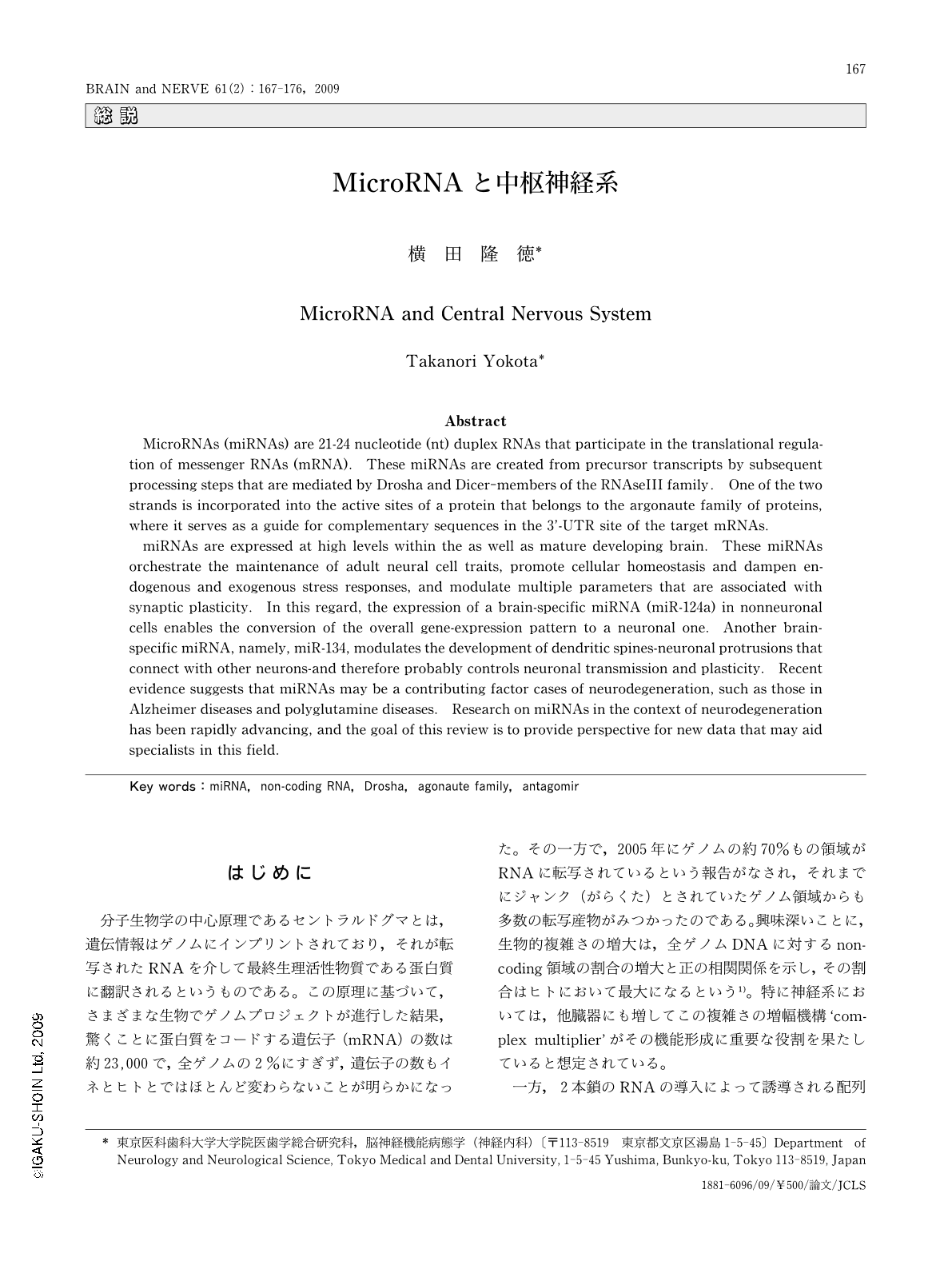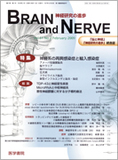Japanese
English
- 有料閲覧
- Abstract 文献概要
- 1ページ目 Look Inside
- 参考文献 Reference
はじめに
分子生物学の中心原理であるセントラルドグマとは,遺伝情報はゲノムにインプリントされており,それが転写されたRNAを介して最終生理活性物質である蛋白質に翻訳されるというものである。この原理に基づいて,さまざまな生物でゲノムプロジェクトが進行した結果,驚くことに蛋白質をコードする遺伝子(mRNA)の数は約23,000で,全ゲノムの2%にすぎず,遺伝子の数もイネとヒトとではほとんど変わらないことが明らかになった。その一方で,2005年にゲノムの約70%もの領域がRNAに転写されているという報告がなされ,それまでにジャンク(がらくた)とされていたゲノム領域からも多数の転写産物がみつかったのである。興味深いことに,生物的複雑さの増大は,全ゲノムDNAに対するnon-coding領域の割合の増大と正の相関関係を示し,その割合はヒトにおいて最大になるという1)。特に神経系においては,他臓器にも増してこの複雑さの増幅機構‘complex multiplier'がその機能形成に重要な役割を果たしていると想定されている。
一方,2本鎖のRNAの導入によって誘導される配列特異的な遺伝子発現抑制であるRNA干渉が発見され,この機構が進化的に保存された生体防御機構であり,遺伝子発現制御やゲノムの品質管理として機能していることがわかった。上記のnon-coding RNAには膨大な数の20~30塩基長の「小さなRNA(small RNA)」があり,これまでのRNA干渉および関連分子経路の解析から,これらの生体内の内因性の小さなRNAが重要な遺伝子発現抑制機構を果たしていることが判明し2),総称して「RNAサイレンシング」と呼ばれている3)。
その後のsmall RNAの研究の進歩はめざましく,piRNA,rasiRNA,ta-siRNAや内因性siRNAなどさまざまなRNAサイレンシングに関わるsmall RNAが同定されている。本稿ではその中で最も研究が進んで,臨床応用への研究も始まったmicroRNA(miRNA)について,その基本知見と神経系との関わりについて概説したい。
Abstract
MicroRNAs (miRNAs) are 21-24 nucleotide (nt) duplex RNAs that participate in the translational regulation of messenger RNAs (mRNA). These miRNAs are created from precursor transcripts by subsequent processing steps that are mediated by Drosha and Dicer-members of the RNAseIII family. One of the two strands is incorporated into the active sites of a protein that belongs to the argonaute family of proteins, where it serves as a guide for complementary sequences in the 3'-UTR site of the target mRNAs.
miRNAs are expressed at high levels within the as well as mature developing brain. These miRNAs orchestrate the maintenance of adult neural cell traits,promote cellular homeostasis and dampen endogenous and exogenous stress responses,and modulate multiple parameters that are associated with synaptic plasticity. In this regard,the expression of a brain-specific miRNA (miR-124a) in nonneuronal cells enables the conversion of the overall gene-expression pattern to a neuronal one. Another brain-specific miRNA,namely,miR-134,modulates the development of dendritic spines-neuronal protrusions that connect with other neurons-and therefore probably controls neuronal transmission and plasticity. Recent evidence suggests that miRNAs may be a contributing factor cases of neurodegeneration,such as those in Alzheimer diseases and polyglutamine diseases. Research on miRNAs in the context of neurodegeneration has been rapidly advancing,and the goal of this review is to provide perspective for new data that may aid specialists in this field.

Copyright © 2009, Igaku-Shoin Ltd. All rights reserved.


